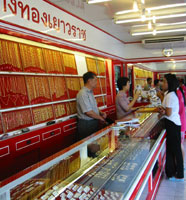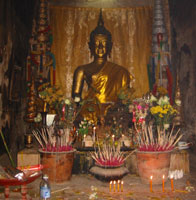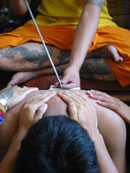Going for gold
The sheer numbers of gold shops in Thailand should be some indication of just how popular this metal is. Usually found grouped together by the dozens and even in the smallest towns, gold shops have quite a bit of hustle and bustle going on around them and it is not just generated by window shoppers out for some fun. If you see throngs of people at a gold shop, it usually means one of two things: the price of gold has dropped or payday just rolled around. Gold shops are painted a bright fire-truck red and almost always belong to Thai-Chinese families. Prices for buying and selling gold are displayed prominently and are updated twice daily.
Thais love gold but this affection for gold goes far beyond aesthetic reasons. Gold represents social status and financial security. Large gold chains are worn by Thailand’s wealthiest members but are also found around the necks of those surviving from paycheck to paycheck. These gold chains usually have Buddhist amulets dangling from them. They are often, but not always, also made out of gold and sometimes are collector’s items themselves.
them. They are often, but not always, also made out of gold and sometimes are collector’s items themselves.
A gold chain is as good as or better than money in the bank as its value will not disappear overnight (unless, of course, it gets stolen). In times of need, just bring your gold chain into a gold shop, have it weighed, and it will be bought back or held until you can afford to pick it up again. If your friend always wears the same gold chain and you find that one day it is missing from his or her neck, it could be that a financial problem has arisen.
Gold is tangible, wearable and historical. Through the centuries, gold has always been universally recognised as a valid form of currency. It may be melted down and changed in shape or style but its intrinsic value always remains. Thais are perhaps more practical and less sentimental when it comes to buying gold. Infants and small children often have gold bracelets with bells attached fitted to their wrists and ankles as a way to help them learn coordination and how to walk. But these bracelets are also savings bonds of sorts.
and ankles as a way to help them learn coordination and how to walk. But these bracelets are also savings bonds of sorts.
Thai gold has a different colour from what one might expect; it gives off a deeper yellow glow. Although many Thais and gold dealers will claim Thai gold is in fact pure gold, this is not true. Thai gold is 23 carat gold; the remaining 3.5 percent of its makeup consists of alloy metals including copper. 18-carat gold would be viewed as absolutely worthless in Thailand as it has no resale value.
Unlike the rest of the world, where gold is weighed in grams or ounces, Thailand weighs gold in a unit called ‘baht’ (the same word used for the nation’s currency). One baht weighs exactly 15.16 grammes and a fine ounce of gold weighs 31.103 grammes. If you’re like me and have no attention span for maths, this weighing method can be a bit confusing.
Besides weight, there is another factor that will determine the price of a piece of jewelry: workmanship. For a one-baht (15.16 gramme) necklace, workmanship cost is likely to range between 300 baht and 8,000 baht (up to US$20) depending on the detail involved. This cost will be lost if the necklace is sold back as gold is bought based solely on weight.
workmanship. For a one-baht (15.16 gramme) necklace, workmanship cost is likely to range between 300 baht and 8,000 baht (up to US$20) depending on the detail involved. This cost will be lost if the necklace is sold back as gold is bought based solely on weight.
Shopping for gold in Thailand is quite easy. Go into a reputable gold store and let the salesclerk know how much you prefer to spend. He or she will calculate how many baht of gold that will allow you to buy and will proceed to show you all the available merchandise fitting that category. Chains are the most popular choice for most Thais but rings, bracelets and pendants are also available. Be sure not to fall for shops offering big discounts on gold, as you’re most likely to walk away with a cheap imitation. As the price of gold is fixed and someone is always willing to buy it at this rate, no one is going to give it away.
The love of gold goes beyond the weights, measure and finances of a gold shop. Gold is a beloved colour and symbol in itself. Look around a Buddhist temple and you will see the colour most everywhere. Buddha images are frequently cast in gold, golden roof awnings sweep into the air, very thin and small square sheets of gold leaf are pressed onto Buddha images as a way of paying homage to them. Gold has long been associated with wealth, royalty and power, so what better way to honour the Lord Buddha and his teachings than by offering the most precious and revered of earthly metals?
